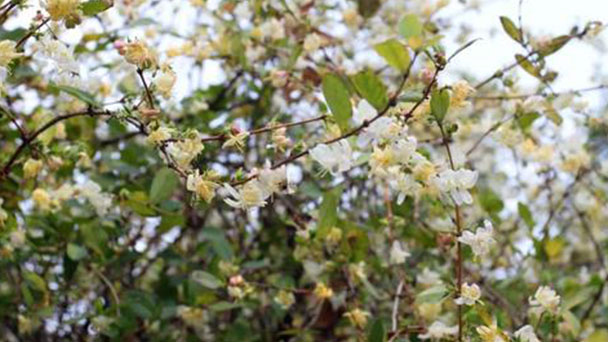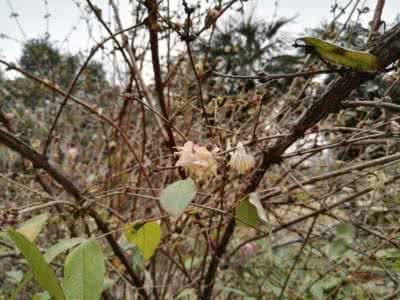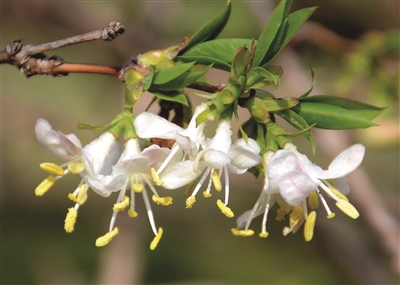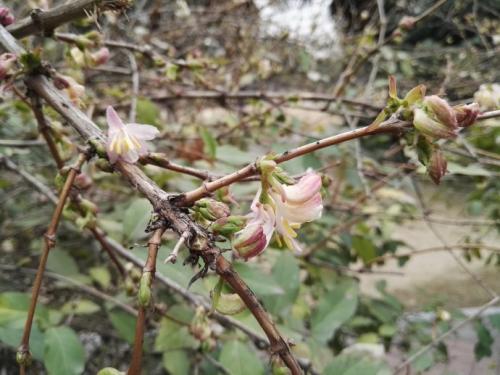Winter honeysuckle profile
Written by Maggie
Nov 01 2021

Lonicera fragrantissima is a species of flowering plant in the honeysuckle family known by the common names Winter Honeysuckle, fragrant honeysuckle, January jasmine, Chinese honeysuckle, kiss-me-at-the-gate, and sweet breath of spring. Winter Honeysuckle is commonly found in forests, thicles and streams on hillsides with an elevation of 100-2000 meters (about 2,700 meters in western Sichuan), spreading in most parts of China. Winter Honeysuckle stems can be used for firewood as well as for weaving material. Its leaves are good fodder for livestock when young. In addition, Winter Honeysuckle can withstand drought, cold and barren, with strong tillering ability and easy reproduction. It is an excellent tree species for soil and water conservation.
Winter Honeysuckle Picture

Winter Honeysuckle Characteristics
Winter Honeysuckle is half evergreen or sometimes deciduous shrub, up to 2 m tall; Young branch does not have hair or sparse by butadil bristles, occasionally be mixed with short glandular hair, hair falls off hind to have small nodular shape protuberance. The old branch is gray-brown. Winter Honeysuckle buds have 1 pair of apical apex of the outer scales, and will cover the inner scales. Thickness papery or leathery, morphological variation is very big, from pour egg elliptic, oblong, ovate, ovate to oblong, oval 3 ~ 7 (8.5) cm long, apex acute or convex, base rounded or broadly cuneate, glabrous or only just hairs, midrib below are a few more or just below the base on both sides of midrib has slightly curved short rough hair, sometimes above midrib hairs. Winter Honeysuckle has a hard edge eyelash or glabrous; The petiole is 2-5 mm long, bristly. Flowers open before or at the same time with leaves, fragrant, in axils of bracts at the base of young branches, pedicels long (2-) 5 -- 10 mm; Bracts are lanceolate to substrate, ca. 2-4 times longer than calyx tube; Winter Honeysuckle calyx tube is connate to middle, 1.5-3 mm long, calyx eaves sub truncate or micro5-lobed; The corolla is white or reddish, 1-1.5 cm long, glabrous or rarely sparsely strigose outside, labiform, tube 4-5 mm long, inner surface densely pilose, base shallowly cystic, upper lip 7-8 mm long, lobes deep to middle, lower lip glossal, 8-10 mm long, reflexed; Stamens are hidden inside, filaments of different lengths; Winter Honeysuckle style is glabrous. The fruit is bright red, rectangular and round, about 1 cm long, partially joined; Seeds are brown, slightly oblate, rectangular, ca. 3.5 mm long, slightly concave. Flowering period is from mid-February to April, fruit ripening from late April to May.
Winter Honeysuckle is a deciduous shrub. Branchlets and petioles sometimes have short strings. Leaves are ovate, elliptic or ovate-lanceolate, lanceolate or ovoid less, usually bristly and short glandular hairs on both surfaces or at least underside midrib bristles, sometimes lower midrib or base flanks mixed with short strigose. Winter Honeysuckle has lower style sparsely strigose. Flowering period is from late January to early April, fruiting from May to June.
Winter Honeysuckle Growing Conditions
Winter Honeysuckle stems from wooded hillsides, scrub forests and streams with an elevation of 100 to 2,000 metres (2,700 metres in western Sichuan).

Winter Honeysuckle Distribution
Winter Honeysuckle is located in the south of Shaanxi and Gansu, northeast of mountains, south and west of Anhui, Zhejiang (Dinghai, Hangzhou and Tianmu Mountains), Jiangxi (Xiushui), Henan, west and southeast of Hubei, Hunan (Cili), west and Northeast of Sichuan, and north and west of Guizhou (Weining). It is cultivated in Shanghai, Hangzhou, Wuhan, Luda and other places. Model specimens were collected from cultivated plants introduced to Britain from Shanghai, China.
Winter Honeysuckle Uses
Winter Honeysuckle stems can be used for firewood as well as for weaving material. Its leaves are good fodder for livestock when young.
Winter Honeysuckle can withstand drought, cold and barren, with strong tillering ability and easy reproduction. It is an excellent tree species for soil and water conservation.

Winter Honeysuckle Propagation
Ramet propagation: Winter Honeysuckle tiller was stronger and autumn ramet survival rate was higher. The method was to dig seedlings with root and soil balls around the Winter Honeysuckle parent plant and plant them steadily with sufficient water
Layering propagation: This can be done from May to September. Take longer branches and bury them in the soil for 10-375px to keep the soil moist. Root can be half a month later, generally in the spring of the second year and mother plants cut off the layering seedlings, and can be divided into transplanting.
Cutting propagation: It can be carried out in the middle and late of June. The semi-lignified branches of the same year are selected as cuttings, and cut into 15-500px cuttings with sharp knives at 2-4mm under the section. The cuttings retain 2-3 nodes and remove the base leaf and 1/3 of the upper leaf. In order to promote rooting and improve the survival rate of cuttings, certain treatment should be carried out before cutting. When cutting, ABT2 root powder can be used to improve the rooting rate. Methods: After dissolving 1g root powder with 500mL 95% alcohol, adding 500ml distilled water or cold boiled water to make 1000mL 1000ppm original solution, and then adding water to dilute to the required concentration of 50ppm for use. Before cutting, dip the base of the branches in 2-4 hours, immediately insert the processed cuttings into the seedbed, the spacing of the lines is 250px×250px, and the depth is 8-250px. After inserting, compacted, so that the substrate is closely connected with the cuttings, and then sprayed with water. Shade properly and keep the bed moist often. Take root after 1 month and transplant seedlings the following year.
Read Next:
Honeysuckle Vine Grow & Care Guide
How to Propagate Winter Honeysuckle
Latest Updated
- Benefits of Bugleweed - 7 Science-backed Health Benefits
- Bugleweed Dangers & Side Effects - Is It Poisonous?
- How to Plant Evergreen Trees - What You Should Know
- When to Plant Evergreens - Grow Guide for Evergreen Trees
- 12 Wonderful Evergreen Shrubs for Your Garden
- 12 Popular Evergreen Plants with Pictures for Beginners
- When And How To Prune A Lilac Bush Like a Pro
- How to Grow & Care for Lilac Vine (Hardenbergia Violacea)
- Japanese Lilac Tree (Syringa Reticulata) Care & Propagation Guide
- Shumard Oak Pros and Cons - What to Know
Popular Articles
- Winter maintenance of Antirrhinum Majus
- How to Grow Terminalia Mantaly Tree
- How to Grow and Care for Crossostephium Chinense
- How to grow Antirrhinum Majus in spring
- Peristeria Elata (Dove Orchid) Profile: Info & Care Guide
- Underwatered Snake Plant (Sansevieria Trifasciata) - Signs And How To Fix
- How to Care for Brazilian Jasmine Plant (Mandevilla Sanderi)
- How to Grow & Care for Graptopetalum Purple Delight in Summer
- Rosa Chinensis (China Rose): Plant Growing & Care Tips
- How to Care for Baby Sun Rose (Aptenia Cordifolia)